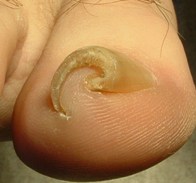 An ingrown nail occurs when the outside nail edge is damaged, and the nail no longer fits properly into the side groove. The nail curls downward and digs into the skin, causing pain, swelling, redness and drainage. Sometimes a piece of nail becomes embedded in the side tissue (lateral-pointing spicule) and the tissue becomes heaped up (hypertrophied). The great toe is the most commonly involved. The lateral side is involved more commonly than the medial side.
An ingrown nail occurs when the outside nail edge is damaged, and the nail no longer fits properly into the side groove. The nail curls downward and digs into the skin, causing pain, swelling, redness and drainage. Sometimes a piece of nail becomes embedded in the side tissue (lateral-pointing spicule) and the tissue becomes heaped up (hypertrophied). The great toe is the most commonly involved. The lateral side is involved more commonly than the medial side.
While there are many causes for ingrown nails, the two most common causes are poorly-fitting shoes and improperly trimmed nails. Tight shoes compress the side of the nail and alter the fit of the nail in the lateral groove. When nails are peeled off or torn, the edge of the nail extends down into the corner of the nail groove. A torn nail can irritate the skin next to the nail, producing inflammation and infection.
The main symptom is pain that is related to the inflammation caused foreign body reaction and mechanical pressure. When the nail bed is compressed from the side, the edge of the nail penetrates the cuticle. A foreign body reaction is set up by the presence of the keratinaceous nail material in the flesh of the toe.
Proper trimming of the nails is the most beneficial way to prevent the formation of an ingrown nail. Nails should be cut straight across, with the corners of the nail protruding from the end of the toe. Teenagers often play with their toes in the bed at night. They can wear socks to bed, to serve as a reminder to avoid peeling or picking at their toenails.
Ingrown toenails may cause serious infection complications in certain high-risk patients with diabetes or arterial insufficiency.
These conservative measures should be enacted as soon as possible and may be sufficient to render surgical treatment unnecessary.
When an ingrown nail is mildly inflamed, soaking the foot in warm water and placing dry cotton under the corner of the nail may be all that is needed. As the ingrown nail worsens, you may develop increasing pain, swelling and drainage. Either topical antibiotics or oral antibiotics can be tried at this stage. Surgery is often needed as the problem becomes more severe. The recommended procedure involves removing a small portion of the outer part of your nail and destroying the nail bed beneath. Partial nail removal with cauterization of the nail matrix is curative in more than 90% of cases, either with RF, laser, cautery or using chemical phenol.





